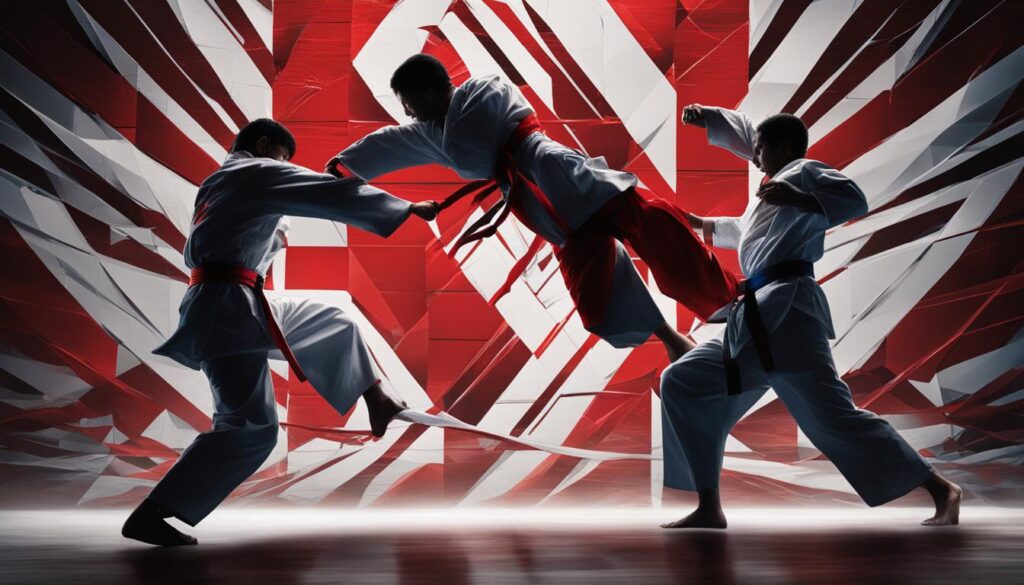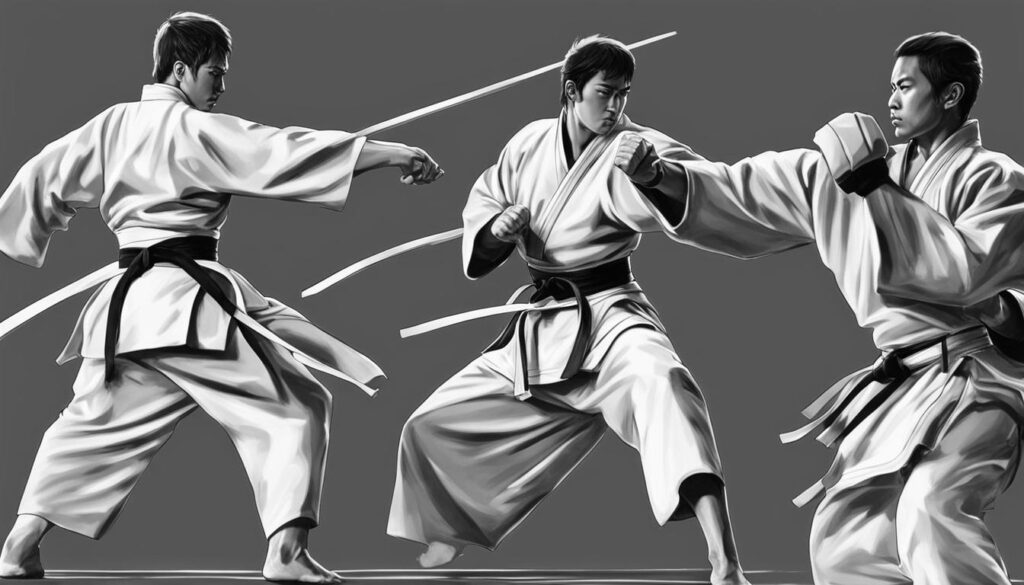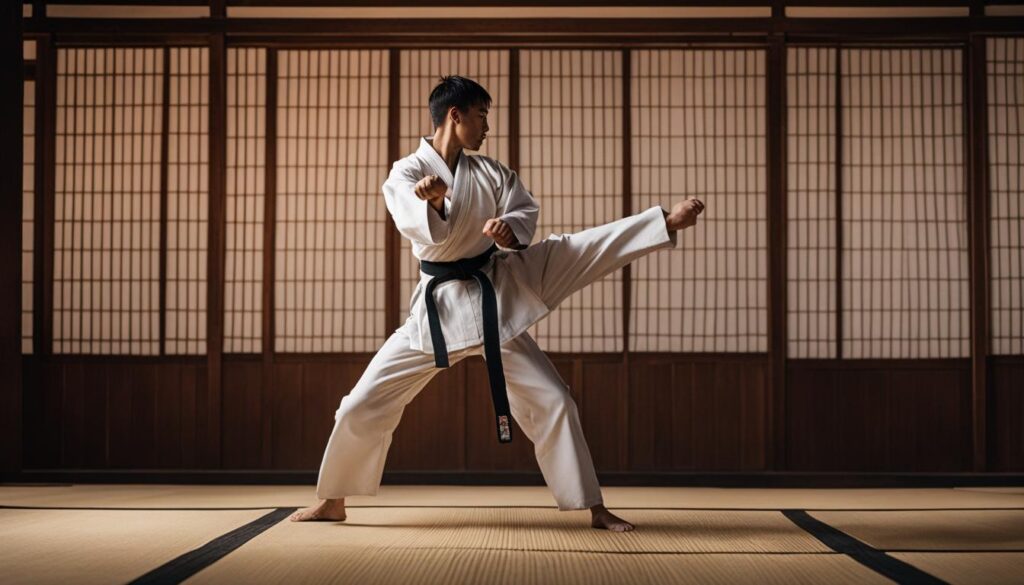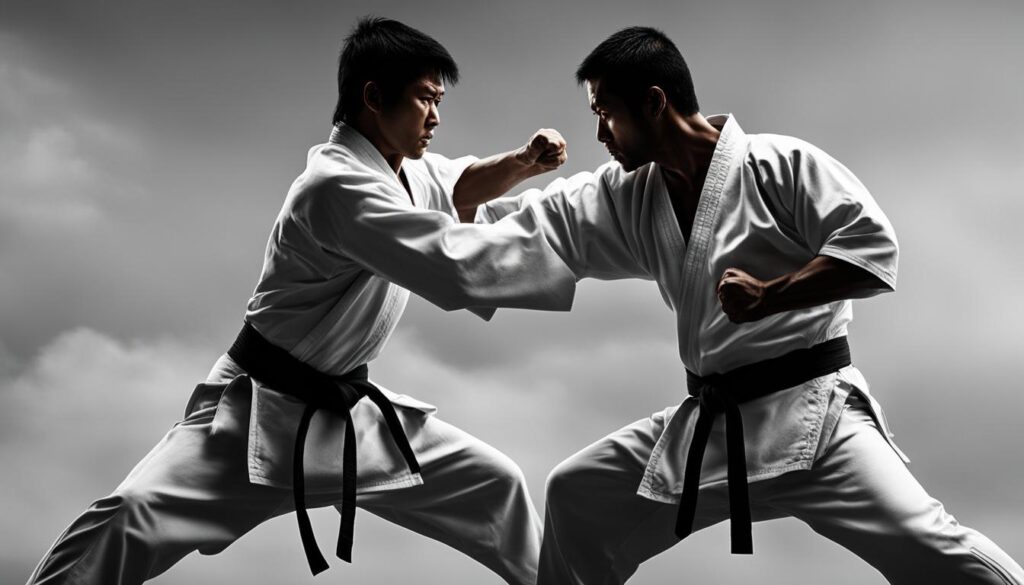Karate, a martial art known for its powerful strikes, utilizes a unique approach when it comes to force application. Unlike other combat sports, in karate, a force that is applied for a short time is more effective. This distinctive aspect of karate has been studied and analyzed to understand the science behind its impact.
When examining the power generation in karate, it becomes evident that the principles of physics come into play. Understanding the concepts of force, momentum, effective mass, and the kinetic chain provides insights into why short-timed force is favored in this martial art.
By understanding the science and employing martial arts force techniques, karate practitioners can enhance their techniques and deliver fast and powerful strikes. Let’s delve deeper into the key factors that contribute to the effectiveness of short-timed force in karate and how it can be maximized in training.
Key Takeaways:
- Short-timed force is more effective in karate due to the specific application and principles of force, momentum, and effective mass in this martial art.
- The science behind karate’s power lies in the understanding of physics, including the impulse-momentum relationship and the importance of speed in generating force.
- Technique and genetics play a role in karate, but evidence-based strength and conditioning training can enhance punch power.
- Effective mass, or the snap generated in the whole body upon impact, is crucial for transferring force and creating momentum in karate techniques.
- The kinetic chain, involving force transfer from the lower body through the core to the arms, is essential for optimizing the effectiveness of karate techniques.
The Science Behind Karate’s Power
The power in karate techniques is influenced by the principles of physics. The force of a punch in karate is dependent on the impulse-momentum relationship, which states that the change in momentum experienced by a body is equal to the impulse of the resultant force.
To generate more force, karate practitioners need to increase their mass and move it quickly. This is why heavyweights in karate are often the strongest hitters. Additionally, speed plays a crucial role in power generation. Punches that are delivered quickly can create more impulse and transfer more force to the target.
The Role of Technique and Genetics
When it comes to power generation in karate, both technique and genetics play important roles. While there is no one-size-fits-all optimal punching technique, having good technique is essential for maximizing punch power. Different boxers with their unique styles and techniques have achieved knockout punches, highlighting the importance of individualization in karate.
Genetics also contribute to factors such as muscle fiber type composition, which can impact an individual’s ability to generate power. However, it’s important to note that these genetic characteristics can be trained and improved through targeted strength and conditioning training.
By focusing on evidence-based training methods, karate practitioners can enhance their overall strength, speed, and explosiveness. This, in turn, leads to improved power generation in their punches. It’s essential to combine technique refinement with targeted exercises that optimize the genetic factors at play.
To visualize the role of technique and genetics in power generation, consider the following table:
| Technique Factors | Genetic Factors |
|---|---|
| Proper alignment and body mechanics | Muscle fiber type composition |
| Rotation and hip movement | Fast twitch muscle fibers |
| Timing and accuracy | Genetics related to strength and power |

The Importance of Effective Mass
Effective mass plays a crucial role in the power and impact of karate techniques. It refers to the snap or brief stiffening of the whole body upon impact, which is essential for transferring force to the target site and creating momentum.
This snap primarily involves the arms, shoulders, and core muscles. By developing core strength and practicing punch-specific movements, karate practitioners can improve their effective mass.
Having a strong core allows for better coordination and control, resulting in more efficient force transfer. It also helps to maintain balance and stability during strikes, optimizing the overall effectiveness of the technique.
Furthermore, muscle tension is an integral component of generating effective mass. The controlled tension in the arms, shoulders, and core facilitates the rapid transfer of force, enhancing the power and speed of the strike.
Overall, focusing on developing core strength and muscle tension can significantly improve the effective mass in karate techniques and increase the power of punches.
The Kinetic Chain in Karate
The kinetic chain in karate plays a crucial role in optimizing the effectiveness of techniques by ensuring efficient force transfer throughout the entire body. It involves a sequence of movements that starts from the lower body, travels through the core and shoulders, and ends with the arms and fists. By enhancing the kinetic chain, karate practitioners can maximize the power and impact of their strikes.
Force transfer in karate begins with the generation of energy in the lower body. The legs and hips act as the foundation for power generation, providing a strong base for explosive movements. As the force travels up through the body, the core muscles play a vital role in stabilizing and transferring the energy seamlessly. A strong and stable core enables the force to flow smoothly from the lower body to the upper body.
In addition to lower body rate of force development, hip mobility is a crucial aspect of the kinetic chain. The ability to generate power comes from the precise coordination of hip movement, which allows for efficient force transfer. Improving hip mobility through targeted exercises and stretches can enhance the overall effectiveness of karate techniques.
Core strength is also essential for the kinetic chain in karate. A strong core provides stability and control during strikes, allowing for optimal force transfer. Training the core muscles through specific exercises such as planks, Russian twists, and leg raises can improve core strength and enhance the kinetic chain.
Rotational and shoulder mobility are key components of the kinetic chain as well. A smooth and controlled rotation of the torso, combined with proper shoulder movement, enables the force generated from the lower body to be efficiently transferred to the arms and fists. Practicing rotational exercises and shoulder mobility drills can enhance the kinetic chain and improve karate techniques.

The kinetic chain in karate is a complex process that involves the coordinated transfer of force through the entire body. By focusing on improving lower body rate of force development, hip mobility, core strength, and rotational/shoulder mobility, karate practitioners can optimize the effectiveness of their techniques and unleash the full power of their strikes.
The Limitations of Karate in Real-World Applications
While karate techniques can be effective in controlled training settings, they may have limitations when applied in real-world self-defense scenarios or MMA competitions. Karate focuses on specific sparring and kata patterns that may not fully prepare practitioners for unpredictable situations. Ground fighting and grappling skills, commonly found in disciplines like Ju-Jitsu, are often necessary to complement karate techniques. However, it is important to note that the effectiveness of karate punches also depends on the individual’s natural fighting instinct and experience.
“The limitations of karate in real-world applications become apparent when practitioners face unfamiliar and dynamic situations where traditional karate techniques may not be as effective. It’s important to supplement karate training with other martial arts disciplines to prepare for a range of scenarios.” – Sensei Hiroshi
The Role of Discipline and Politics in Karate
Karate is a martial art that embodies the principles of discipline and self-control. However, within the realm of martial arts organizations, it is not uncommon to encounter a culture of politics. As practitioners progress in their ranks and compete in tournaments, they may face challenges related to politics and hierarchy.
In some dojos, personal relationships with instructors and favoritism can influence tournament results and ranking promotions. This deviation from the true essence of discipline can hinder fair competition and undermine the integrity of karate training. It is crucial to foster an environment where merit and skill are the sole determining factors in a practitioner’s progress.
“Discipline is the bridge between goals and accomplishment.” – Jim Rohn
To address this issue, karate organizations should prioritize transparency, fairness, and accountability in their policies and practices. By implementing clear evaluation criteria, impartial judging systems, and opportunities for honest feedback, the discipline and integrity of karate can be upheld.
Additionally, it is essential for practitioners to prioritize self-discipline and uphold the core values of karate, both inside and outside the dojo. This includes maintaining humility, respect, and continuous self-improvement. By embodying these principles, practitioners can contribute to a harmonious and focused training environment.
Ultimately, the role of discipline in karate extends beyond the physical aspects of training. It encompasses the development of mental fortitude, emotional resilience, and ethical conduct. By upholding these values, practitioners can cultivate a true sense of discipline in their karate journey, setting a positive example for the martial arts community as a whole.

The Importance of Fair Competition
A fair competition system is crucial in karate to ensure that practitioners are evaluated objectively based on their skills and abilities. By enforcing strict rules and guidelines, tournaments can provide a platform for practitioners to showcase their talent and dedication. Fair competition not only motivates practitioners to improve but also inspires others to join and invest in their karate journey.
| Benefits of Fair Competition | Consequences of Politics |
|---|---|
|
|
Creating a level playing field requires an ongoing commitment to fairness and transparency. Karate organizations must address politics and hierarchy to ensure that discipline remains at the forefront of the martial arts community. By fostering an environment where practitioners are judged solely on their abilities and character, karate can continue to thrive as an honorable and respected martial art.
The Importance of Technique Over Raw Power
When it comes to karate, technique plays a crucial role in the effectiveness of techniques, surpassing raw power alone. While power is undoubtedly important, it is not the sole determinant of success in karate. Skilled fighters understand that natural fighting instincts and experience can often outweigh sheer power when it comes to achieving victory.
Winning tournaments and becoming a proficient karate practitioner requires a combination of technical proficiency, strategic thinking, and adaptability. It is not enough to rely solely on brute strength; one must learn to harness that power effectively through precise techniques and well-timed attacks.
By honing their technique, karate practitioners can maximize the impact of their strikes even with less inherent power. Technique allows fighters to deliver fast, accurate blows that exploit an opponent’s vulnerabilities, while raw power alone may falter in the face of skilled defensive maneuvers.
“Technique and skill outweigh pure strength and power. A smart fighter knows how and when to apply technique to overcome any opponent.”
Additionally, technique provides a foundation for adaptability in combat. The ability to vary techniques, to seamlessly transition between strikes, blocks, and counters, gives karate practitioners an edge over opponents who rely solely on power. This adaptability allows fighters to respond swiftly to changing circumstances and exploit emerging opportunities.
Ultimately, the cornerstone of effective karate lies in the cultivation of technique. While power can enhance the impact of strikes, it is the fighter’s ability to apply technique with precision, adaptability, and strategic thinking that separates the truly skilled from the merely powerful.

| Raw Power | Technique | Fighting Instinct | Natural Fighting Ability |
|---|---|---|---|
| Relies on sheer force | Requires precision and skill | Can be developed through training | Influenced by genetics and experience |
| May overpower opponents with less skill | Allows for exploiting vulnerabilities | Enhances responsiveness and adaptability | Affects intuition and instincts |
| Can be limited against skilled opponents | Provides a foundation for success | Can be honed through practice | Combines with technique for optimal results |
The Challenges of Balancing Karate and Personal Life
Devoting oneself to karate training requires a significant commitment. However, this commitment can sometimes lead to sacrificing personal life and other commitments. The pressure to prioritize karate above all else can strain relationships, create conflicts with work or family responsibilities, and require difficult sacrifices.
Striking a balance between the demands of karate and personal life is a common challenge for many practitioners. It requires careful time management, effective communication, and a strong support system. Prioritizing karate while maintaining healthy relationships and meeting other obligations can be a delicate juggling act that requires constant effort and understanding from all parties involved.
For those with families, the challenge of balancing karate and personal life becomes even more complex. It may require coordinating training schedules with family activities, finding time for shared meals, and being present for important milestones and events. It can be a test of commitment, as sacrifices may need to be made to ensure that both karate and family are given the necessary attention and care.
Sacrifices in karate may go beyond personal life to include other activities and interests. The dedication to training and improving karate skills often means putting other hobbies, sports, or social outings on hold. It is a conscious decision to prioritize karate above other pursuits, which can be challenging but is necessary for growth and progress in the martial art.
Ultimately, finding a balance between karate and personal life requires open communication, understanding, and a willingness to make compromises. It is about recognizing the value of karate and the personal fulfillment it brings, while also ensuring that personal relationships and responsibilities are not neglected.
Whether it’s through effective time management, involving family members in karate activities, or seeking support from fellow practitioners, navigating the challenges of balancing karate and personal life is an ongoing journey. It requires commitment, perseverance, and a deep understanding of the importance of both karate and personal well-being.
The Decision to Leave Karate
Leaving karate can be a challenging decision, especially when there is a strong sense of community and loyalty within the dojo. However, there may come a time when you need to move on from karate to pursue personal growth or explore other interests. It is essential to recognize that leaving is a personal choice that should be respected.
One of the challenges of leaving karate is the potential for feelings of guilt or being seen as disloyal. As a martial art that emphasizes discipline and commitment, there may be pressure to continue practicing karate even when it no longer aligns with your goals or interests. It’s important to remember that prioritizing your own well-being and personal growth is not a betrayal but a necessary step forward.
Furthermore, some dojos may have a cult-like mentality, where leaving is met with accusations of lacking honor or loyalty. It’s crucial to understand that you have the right to explore different paths and make decisions that are best for you. Your value as an individual extends beyond your involvement in karate.
Leaving karate can open up opportunities for self-discovery and the pursuit of new passions. It doesn’t diminish the skills and experiences you gained while practicing karate. Instead, it allows for personal growth and the ability to expand your horizons.
Remember, the decision to leave karate is yours alone. Embrace your journey and confidently move forward, knowing that you are making choices that align with your personal goals and aspirations.
Conclusion
In conclusion, the application of short-timed force is key to maximizing the impact of karate techniques. By understanding the principles of physics, combined with honing technique, considering genetic factors, focusing on effective mass, and optimizing the kinetic chain, karate practitioners can enhance the power generation of their strikes. While it’s important to acknowledge the limitations of karate in real-world scenarios and the need for discipline and commitment, karate remains a valuable martial art for personal growth and self-defense when complemented by other fighting skills. Finding a balance between karate and personal life, as well as knowing when to transition from karate, are crucial factors for practitioners to consider.
FAQ
Why is a force that is applied for a short time more effective in karate?
Short-timed force in karate is more effective because it allows for quicker transmission of force, increasing the impulse and power generated in strikes.
What is the role of technique and genetics in karate?
Technique and genetics both play a role in karate. Good technique is essential for maximizing punch power, while genetics can influence factors such as muscle fiber type composition.
How does effective mass contribute to the power of karate techniques?
Effective mass refers to the snap or brief stiffening of the body upon impact in karate. It helps transfer force to the target site and create momentum, significantly increasing the power of a punch.
What is the kinetic chain in karate?
The kinetic chain in karate refers to the pattern of force transfer that occurs throughout the entire body during explosive actions. It involves generating force from the lower body, transferring it through the core and shoulders to the arms and fists.
What are the limitations of karate in real-world applications?
While karate techniques can be effective in controlled training settings, they may have limitations in real-world self-defense scenarios or mixed martial arts competitions. Ground fighting and grappling skills are often necessary to complement karate techniques.
What is the role of discipline and politics in karate?
Karate is often associated with discipline, but it can also foster a culture of politics within martial arts organizations. Politics and personal relationships with instructors can sometimes influence tournament results and ranking promotions.
Is raw power the only determining factor for successful karate techniques?
No, raw power is not the only determining factor for successful karate techniques. Natural fighting instincts and experience also play a crucial role in performance and skill.
How can practitioners balance karate with personal life?
Balancing karate with personal life can be a challenge. It requires managing training sessions and prioritizing karate while still fulfilling obligations and maintaining relationships outside of the dojo.
When is it appropriate to leave karate?
The decision to leave karate is a personal choice and may be necessary for personal growth or pursuing other interests. It is important to recognize that leaving is a valid decision and can be part of one’s journey in martial arts.
What is the conclusion regarding the impact of short-timed force in karate?
Short-timed force in karate is more effective in generating power and enhancing techniques. Understanding the principles of physics, technique, effective mass, and the kinetic chain can further optimize the impact of force in karate strikes.
